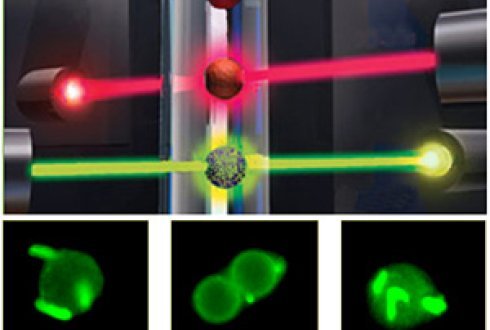Wageningen, The Netherlands
December 15, 2014
By Plant Research International

Instead of one specific diagnostic test for every unique bacteria, virus, fungus or nematode, it has recently become possible to detect dozens of different pathogens on plant material at the same time. One of these multiplex detection technologies is the Luminex system. “We now have over one hundred different types of miniscule beads available, each of which can detect their own pathogen from the plant material,” says Jan Bergervoet, scientist at Wageningen UR and one of the developers of the test.
Beads
At the heart of the Luminex technology are small ‘beads’ of approximately six micrometres in size. “We can attach specific antibodies to these beads that react very specifically to a protein of a sought pathogen,” Bergervoet explains. “If we don’t have any antibodies for a specific pathogen, the technology can use segments of specific DNA or RNA from the relevant pathogen. Mix a series of these beads with a little pulverised plant material and you can ‘light up’ the beads that detect their pathogen with a fluorescent substance. They are then detected by the Luminex machine, which tells you what the plant material contains… And what it doesn’t contain!”
Notorious pathogens
With over 100 beads now available, dozens of notorious pathogens can be detected at once, says Bergervoet. “We have antibodies available against multiple pathogens in tomatoes (such as the tomato mosaic virus and the tomato spotted wilt virus). And we also have specific markers that can be attached to the beads for pospiviroids (such as the potato spindle tuber viroid).”
For breeders and plant pathogen testing services
“The ‘Multiplex Luminex technology’ is not only useful for large breeders,” continues Peter Bonants, team leader Diagnostic Development. “It is of course cheaper and faster for them to check for a whole series of possible pathogens at once. But it can also be used by plant pathogen testing services, for instance, to test material for import or export in one go.”
Expansion kits for new antibodies
There are already many different ‘kits’ available and validated for various antibodies and DNA or RNA markers. “But by definition the system will be in constant development,” says Bonants. “We will continue to try and find new antibodies or DNA or RNA markers for new pathogens, and also for so-called ‘look-alikes’ which sometimes cause false results in conventional diagnostic methods. The Clavibacter bacteria in tomato breeding, for instance, has bacteria that cross-react in conventional diagnostics. This system means you can also establish or exclude these look-alikes in one go.’
Tientallen ziekteverwekkers, in één keer gecheckt
In plaats van één specifieke diagnostische test, voor iedere specifieke bacterie, virus, schimmel of nematode, is het sinds kort mogelijk om tientallen verschillende ziekteverwekkers in plantmateriaal in één keer te detecteren. Dit wordt multiplex-detectie genoemd. Eén van die multiplex-technieken is het Luminex-systeem. ‘In totaal hebben we nu ruim honderd verschillende soorten minuscule bolletjes beschikbaar, die allemaal hun eigen ziekteverwekker in het plantmateriaal kunnen pikken’, zegt één van de ontwikkelaars van de test, Wageningen UR-onderzoeker Jan Bergervoet.
Pareltjes
Het hart van de Luminex-techniek wordt gevormd door kleine ‘pareltjes’, van ongeveer zes micrometer groot. ‘Op die pareltjes kunnen we specifieke antilichamen plakken, die heel gericht met een eiwit van een bepaalde ziekteverwekker reageren’, legt Bergervoet uit. ‘Als we van een potentiële ziekteverwekker nog géén antilichamen hebben, dan kun je ook stukjes specifiek DNA of RNA van het betreffende pathogeen nemen. Meng je een hele serie van die verschillende pareltjes met wat vermalen plantmateriaal, dan kun je díe bolletjes die hun ziekteverwekker hebben gevonden vervolgens laten “oplichten” met een fluorescerende kleurstof. Die worden dan weer door het Luminex-apparaat gedetecteerd, waarna je weet wat er in je planten zit. En ook wat niet, natuurlijk.’
Vele notoire plaaggeesten
Met de nu ruim honderd beschikbare pareltjes kunnen tientallen notoire plaaggeesten tegelijkertijd worden gedetecteerd, vertelt Bergervoet. ‘Tegen meerdere ziekteverwekkers in tomaat, bijvoorbeeld het tomatenmozaïekvirus en het tomatenbronsvlekkenvirus, hebben we antilichamen beschikbaar. En voor de pospiviroiden (onder andere de Potato Spindle Tuber Viroid) hebben we specifieke merkers die we op de pareltjes kunnen hechten.’
Voor telers en plantenziektekundige diensten
‘De 'Multiplex Luminex-techniek' is niet alleen handig voor grotere telers’, zegt teamleider Diagnostiekontwikkeling, Peter Bonants. ‘Voor die telers is het natuurlijk goedkoper en sneller om in één keer een hele serie mogelijke ziekteverwekkers te checken. Maar ook voor bijvoorbeeld plantenziektekundige diensten is het goed om materiaal voor in- of export in één keer te kunnen testen.’
Uitbreidings-kits voor nieuwe antilichamen
Er zijn nu al verschillende ‘kits’ beschikbaar en gevalideerd voor verschillende antilichamen en DNA- of RNA-markers. ‘Maar dit systeem blijft per definitie continu in ontwikkeling’, zegt Bonants. ‘We zullen steeds nieuwe antilichamen en DNA- of RNA-markers proberen te vinden voor weer nieuwe ziekteverwekkers, en ook voor zogenoemde look-alikes, die met conventionele diagnostiek nog wel eens vals positieve uitslagen genereren. De bacterie Clavibacter bijvoorbeeld, kent in de tomatenteelt bacteriën die kruisreageren met de conventionele diagnostiek. Met dit systeem kun je in één run ook die look-alikes aantonen of uitsluiten.’